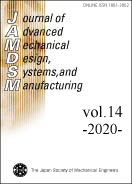14 巻, 5 号
選択された号の論文の13件中1~13を表示しています
- |<
- <
- 1
- >
- >|
Special Issue on Advanced Production Scheduling
-
2020 年 14 巻 5 号 p. JAMDSM0065
発行日: 2020年
公開日: 2020/07/01
PDF形式でダウンロード (708K)
Papers(Special Issue)
-
2020 年 14 巻 5 号 p. JAMDSM0066
発行日: 2020年
公開日: 2020/07/01
PDF形式でダウンロード (767K) -
2020 年 14 巻 5 号 p. JAMDSM0067
発行日: 2020年
公開日: 2020/07/01
PDF形式でダウンロード (990K) -
2020 年 14 巻 5 号 p. JAMDSM0068
発行日: 2020年
公開日: 2020/07/01
PDF形式でダウンロード (820K) -
2020 年 14 巻 5 号 p. JAMDSM0069
発行日: 2020年
公開日: 2020/07/01
PDF形式でダウンロード (5146K) -
2020 年 14 巻 5 号 p. JAMDSM0070
発行日: 2020年
公開日: 2020/07/01
PDF形式でダウンロード (3821K) -
2020 年 14 巻 5 号 p. JAMDSM0071
発行日: 2020年
公開日: 2020/07/01
PDF形式でダウンロード (1374K) -
2020 年 14 巻 5 号 p. JAMDSM0072
発行日: 2020年
公開日: 2020/07/01
PDF形式でダウンロード (1576K) -
2020 年 14 巻 5 号 p. JAMDSM0073
発行日: 2020年
公開日: 2020/07/01
PDF形式でダウンロード (915K) -
2020 年 14 巻 5 号 p. JAMDSM0074
発行日: 2020年
公開日: 2020/07/01
PDF形式でダウンロード (761K) -
2020 年 14 巻 5 号 p. JAMDSM0075
発行日: 2020年
公開日: 2020/07/01
PDF形式でダウンロード (1194K) -
2020 年 14 巻 5 号 p. JAMDSM0076
発行日: 2020年
公開日: 2020/07/01
PDF形式でダウンロード (968K) -
2020 年 14 巻 5 号 p. JAMDSM0077
発行日: 2020年
公開日: 2020/07/01
PDF形式でダウンロード (1864K)
- |<
- <
- 1
- >
- >|
